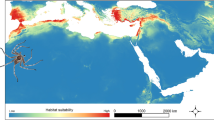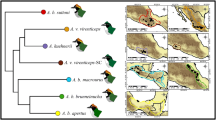Abstract
The Sechura Desert of Peru is among the most arid, barren regions of South America. Four species of nocturnal geckos (Phyllodactylus) are parapatric in part of the desert. By comparing niche associations of these species in allopatry and parapatry, I attempt to determine whether the observed parapatric distributions and niche dimension complementarity are related to competition — as is frequently assumed. While parapatry suggests a role for competition, distributional patterns can alternatively be related to adaptations of geckos to different physical environments (sandy desert and rocky foothill) that abut in the study area. Niche complementarity might also be a result of competition, but potentially contradictory evidence suggests that niche complementarity might instead be the result of adaptations developed in allopatry and having no relationship to competition. The ambiguity of these interpretations sets limits on the significance of this kind of evidence: in the absence of attempts to falsify alternative explanations, observations of parapatry or of niche dimension complementarity do not demonstrate conclusively the impact of competition as a force structuring communities.
Similar content being viewed by others
References
Andrewartha, H.G., Birch, L.C.: The distribution and abundance of animals. Chicago: Univ. Chicago Press 1954
Cody, M.L.: Competition and the structure of bird communities, Princeton, N.J.: Princeton Univ. Press 1974
Connell, J.H.: Some mechanisms producing structure in natural communities. In: Ecology and evolution of communities, (M.L. Cody, J.M. Diamond, eds.), pp. 460–490. Cambridge: Harvard Univ. Press 1975
Dayton, P.K.: Two cases of resource partitioning in an intertidal community: making the right prediction for the wrong reason. Am. Nat. 107, 662–670 (1973)
Dixon, J.R., Huey, R.B.: Systematics of the lizards of the gekkonid genus Phyllodactylus of mainland South America. Los Angeles Co. Mus. Contri. Sci. 192, 1–78 (1970)
Hall, W.P., Selander, W.P.: Hybridization of karyotypically differentiated populations in the Sceleporus grammicus complex (Iguanidae). Evolution 27, 226–242 (1973)
Huey, R.B.: Ecological relations of sympatric Phyllodactylus in the Sechura Desert of Peru. Austin, Texas: Univ. Texas, M.S. Thesis (1969a)
Huey, R.B.: Winter diet of the Peruvian Desert fox. Ecology 50, 1089–1091 (1969b)
Huey, R.B., Pianka, E.R.: Patterns of niche overlap among broadly sympatric versus narrowly sympatric Kalahari lizards (Scincidae: Mabuya). Ecology 58, 119–129 (1977)
MacArthur, R.H.: Geographical ecology. New York: Harper and Row (1972)
Mayr, E.: Animal species and evolution. Cambridge: Belknap Press, Harvard Univ. (1963)
Pianka, E.R.: On lizard species diversity: North American flatland deserts. Ecology 48, 333–351 (1967)
Pianka, E.R.: Notes on the biology of Varanus caudolineatus and Varanus gilleni. Western Australian Nat. 11, 76–82 (1969)
Pianka, E.R.: The structure of lizard communities. Annu. Rev. Ecol. Syst. 4, 53–74 (1973)
Pianka, E.R.: Competition and niche theory. In: Theoretical ecology, principles and application, (R.M. May, ed.), pp. 199–141, Philadelphia: W.B. Saunders Co. 1976
Pianka, E.R., Huey, R.B.: Comparative evology, resource utilization and niche segregation among gekkonid lizards in the southern Kalahari. Copeia 1978, 692–702 (1978)
Pianka, E.R., Pianka, H.D.: Comparative ecology of twelve species of nocturnal lizards (Gekkonidae) in the Western Australian Desert. Copeia 1976, 125–142 (1976)
Rosenzweig, M.L.: On the evolution of habitat selection. Proc. 1st Int. Congress of Ecology, pp. 401–404 (1974)
Rosenzweig, M.L., Winakur, J.: Population ecology of desert rodent communities: habitats and environmental complexity. Ecology 50, 558–572 (1969)
Schoener, T.W.: Resource partitioning in ecological communities. Science 185, 27–39 (1974)
Schoener, T.W.: Presence and absence of habitat shift in some widespread lizard species. Ecol. Monogr. 45, 233–258 (1975)
Schoener, T.W.: Competition and the niche. In: Biology of the reptilia, Vol. 7 (C. Gans, D.W. Tinkle, eds.), pp. 35–136. New York: Academic Press 1977
Selander, R.K., Giller, D.R.: Species limits in the woodpecker genus Centrurus (Aves). Am. Mus. Nat. Hist., Bull. 124, 217–273 (1963)
Sokal, R.R., Rohlf, F.J.: Biometry. San Francisco: W.H. Freeman and Co. 1969
Tosi, J.A.: Zonas de vida natural en el Perú, Memoria Explicativa sobre el mapa ecológico de Perú. Bol. Tec., (5), Inst. Interamer. Cien. Agr. oea Zona Andina (1960)
Author information
Authors and Affiliations
Rights and permissions
About this article
Cite this article
Huey, R.B. Parapatry and niche complementarity of Peruvian Desert geckos (Phyllodactylus): the ambiguous role of competition. Oecologia 38, 249–259 (1979). https://doi.org/10.1007/BF00345186
Received:
Issue Date:
DOI: https://doi.org/10.1007/BF00345186




